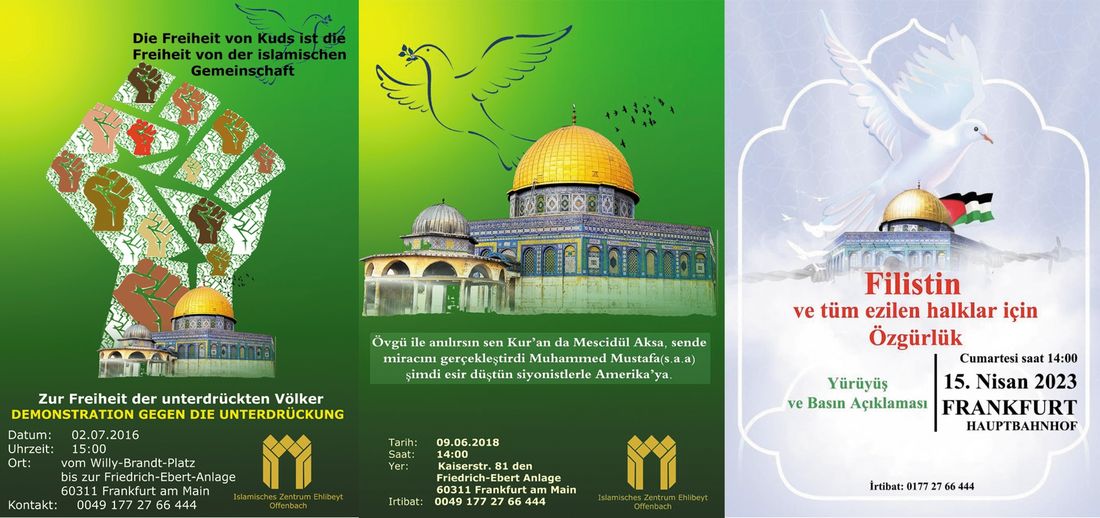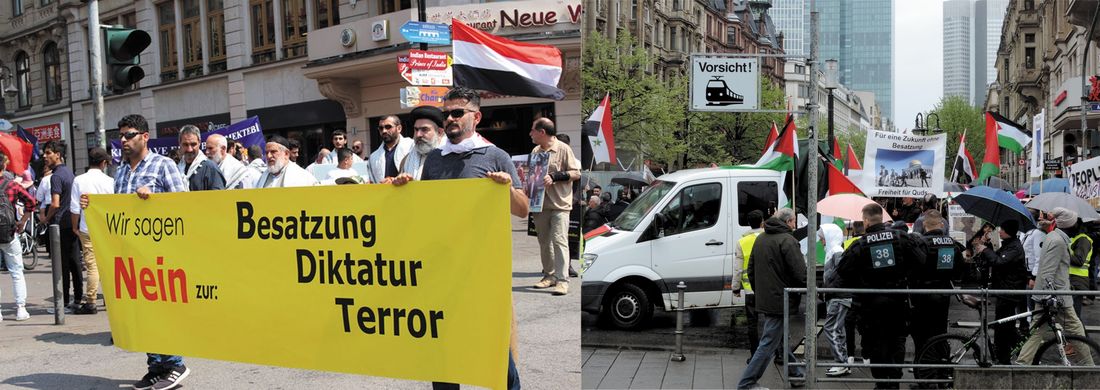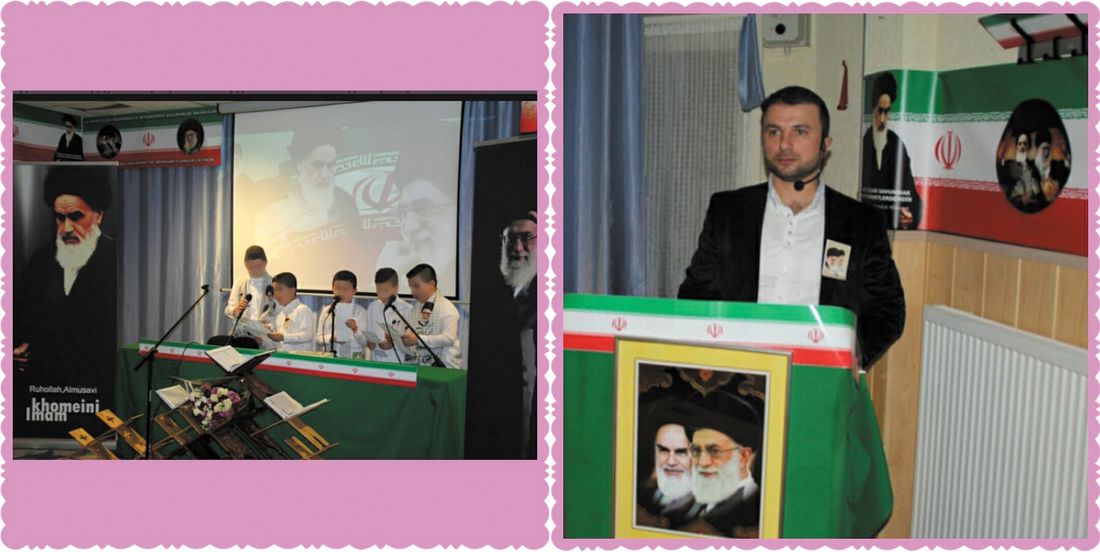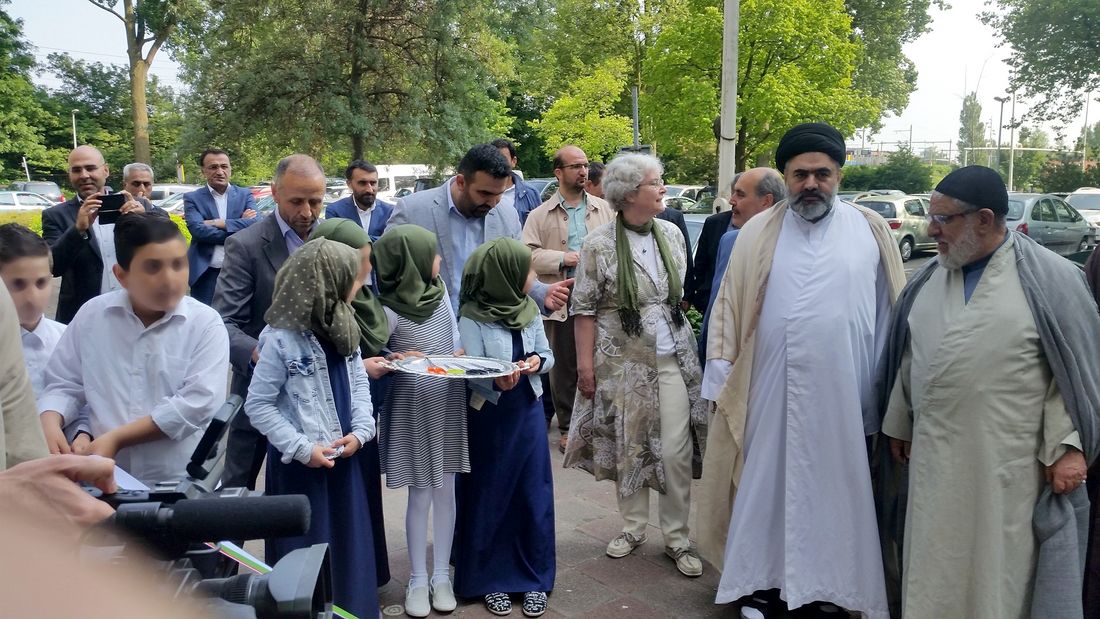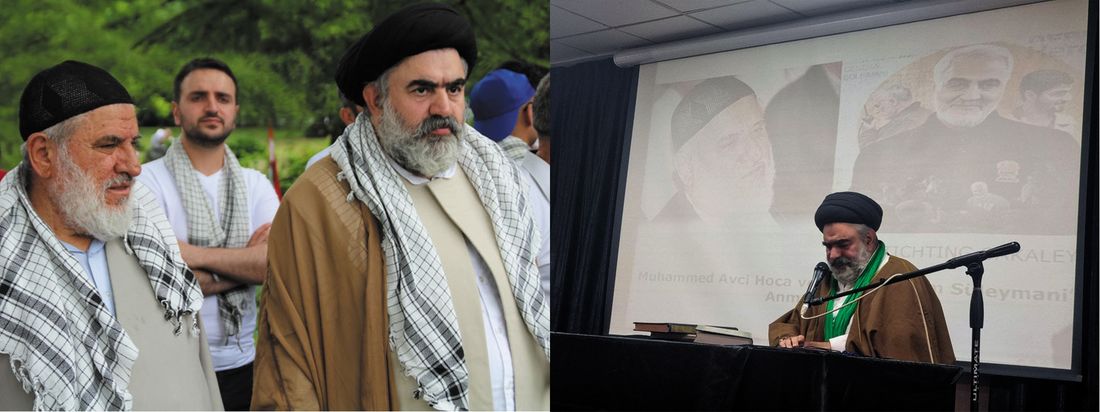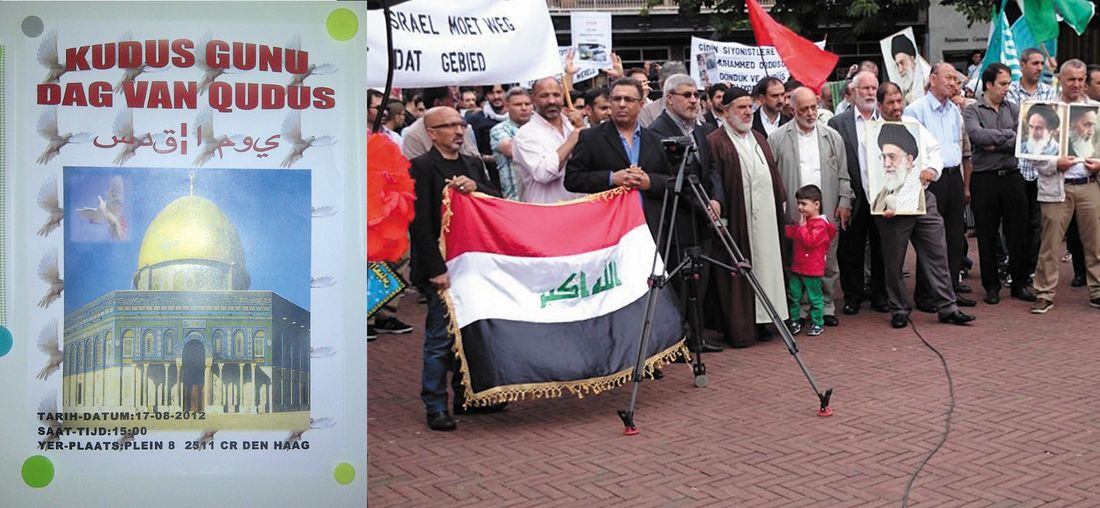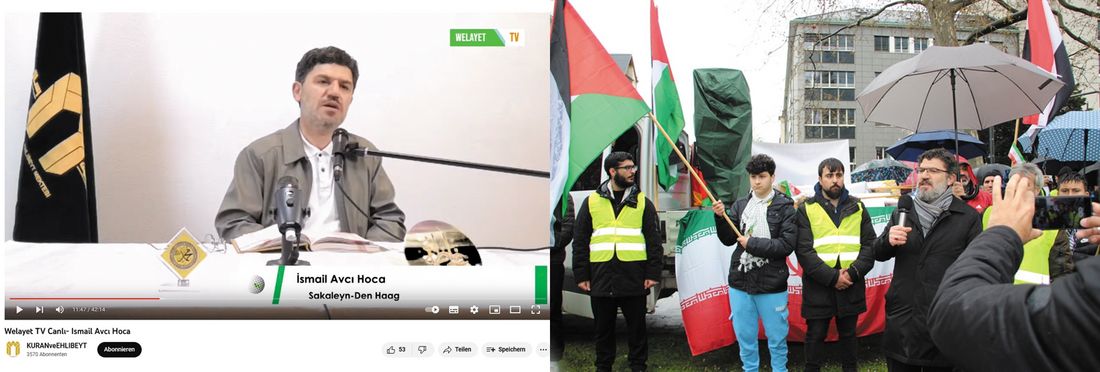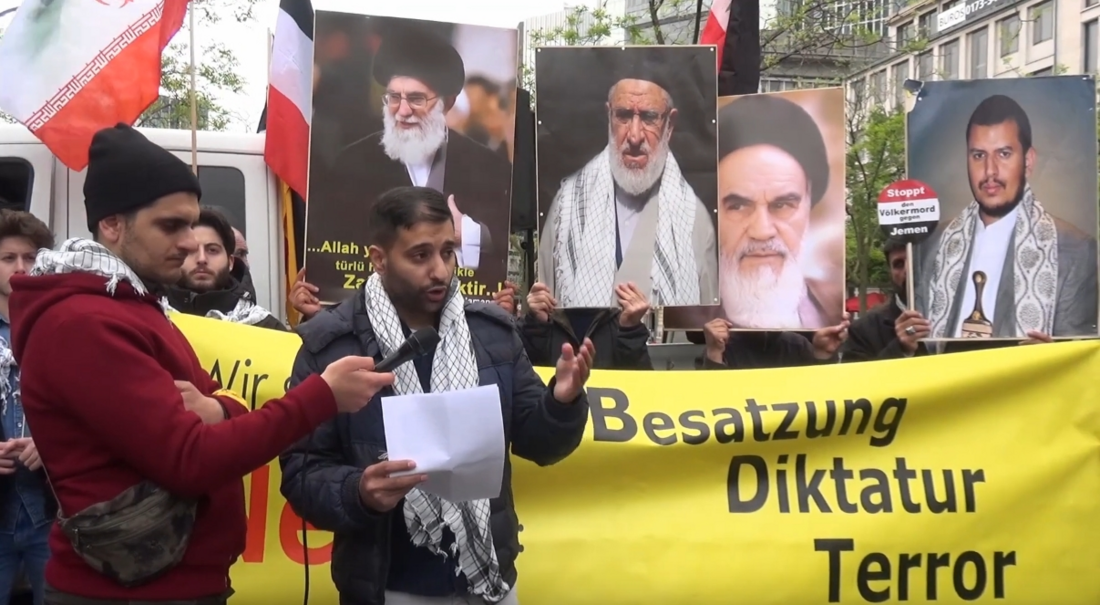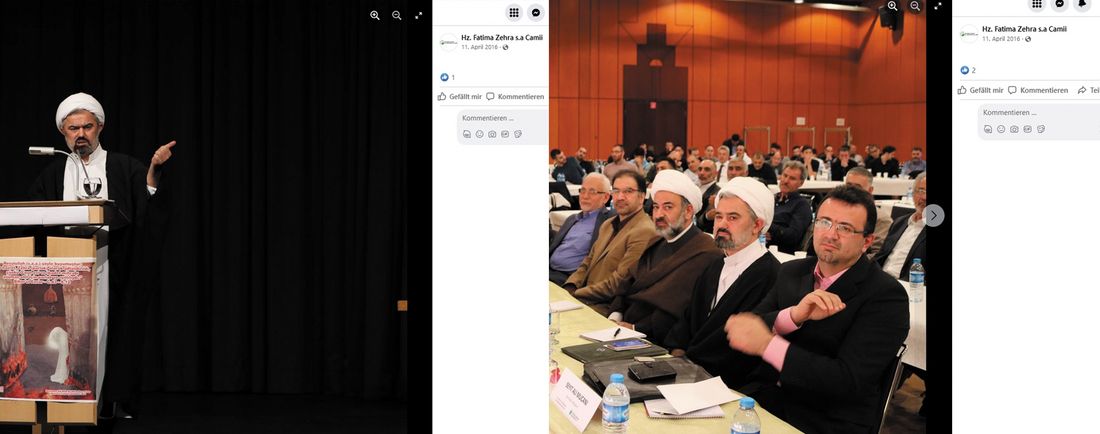Quds Day in Frankfurt and the Ehlibeyt network within the IGS
by Emil Mink
In the founding year of the Islamic Republic, the Iranian regime proclaimed the so-called Quds Day for the "liberation" of Jerusalem (al Quds means "The Holy" and is the Arabic name of the city) and the destruction of Israel. Since 1979, this has been publicly celebrated every year on the last Friday of Ramadan, not only in Iran and its satrapies in the Middle East, but also worldwide, including in Germany. In Germany, marches have been taking place on Quds Day since the 1980s1 . From 1996, supporters of the Islamic Republic mobilised annually for a central event in reunified Berlin. Since 2015, Frankfurt am Main has established itself as another permanent venue alongside the central march in Berlin, although it has tended to take a back seat in the national context. This text looks at the Frankfurt offshoot and its particular organisational structure. To this end, the general background to Quds Day is briefly explained, followed by a description of the development of the Frankfurt branch from 2015 to 2023. The network of the organisers is then examined, which requires both a political-religious classification and some biographical background information on the imam of the registration community. The German network behind the Frankfurt Quds Day and its connections to the Netherlands are then analysed. The network's points of contact with other Shiite organisations in the region will then be considered, with the final step being to formulate an outlook.
1 Background to Quds Day
In 1979, the uprising against the authoritarian ruling dynasty of the Pahlavis in Iran resulted in a revolution against the monarchy, at the end of which a new state emerged under the leadership of Islamist clerics. The subsequent so-called Islamic Republic of Iran was not only directed against the king's form of rule, but also against his pro-Western policies and modernisation efforts. The ideology of the "Islamic movement" and its revolutionary leader Ruhollah Khomeini is anti-Western, anti-imperialist and represents a negative reaction to modernity mediated by the world market, which places the idea of the individual in the place of the collective and society in the place of the community. Political scientist Ulrike Marz therefore characterises the Islamic Revolution as "modern anti-modernism" and explains in her article of the same name why anti-modernism inevitably goes hand in hand with hostility towards Jews. However, the focus of this text is on the network behind the Frankfurt Quds Day and not on the socio-political conditions for the strengthening of Islamist ideology. The latter can be read elsewhere.2 Just a few weeks after the founding of the Islamic Republic, Khomeini proclaimed Jerusalem Day and summed up the first anti-Israeli mass demonstrations in Iran with the words: "Al-Quds Day is an Islamic day and a day for the mobilisation of Muslims. I hope that this day will be the basis for founding a party of all the oppressed of the world. [...] They can then eliminate all the problems that stand in their way and stand up against arrogance. They will raise the banner of Islam and establish the rule of the poor in the world. Until now, Muslims have been divided. Today we have a model for Islamic unity. This must be realised on a broad basis, in all sections of the population, today and in the future. The party of the poor is called 'Hezbollah' [Party of God]. This party is in favour of the rule of God. [...] Imam Ali is our role model. He drew his sword against the conspirators. It is said that he killed seven hundred Jews in one day. [...] The Imam of the Muslims was also vengeful. When it is time for mercy, there is mercy. But when it is the time for revenge, then there is revenge. "3
This quote already reveals various motifs of the Islamist ideology of the mullah regime. Not only is an anti-Semitic promise of salvation invoked, which associates the Jews with all evil in the world and according to which all oppression would disappear with a world cleansed of Jews. This idea of salvation has outlived the revolutionary leader and is one of the ideological pillars of the Islamic Republic today. At the same time, it calls for the unification of the Islamic faith community and the overcoming of confessional divisions in the form of a pan-Islamist world movement, which is ultimately intended to be an Iranian export product under the banner of Khomeini's ideology. The so-called export of revolution, which includes the support of both Shiite and Sunni militias, is enshrined in the Iranian constitution4 and represents another important pillar of the Islamic state of Iran. For this reason, various Islamist organisations adopted the name "Hezbollah" in the 1980s.
The best-known and most important of these organisations is the Shiite Lebanese militia of the same name, which is still closely linked to the Islamic Republic today.5 Political-religious networks are essential for the export of revolution, which organise the annual Quds Days at local and regional level in accordance with the anti-Semitic desire for annihilation. In the 1980s, marches already took place in neighbouring countries in the Middle East and, from 1984 at the latest, in Cologne in West Germany. Since the 1990s, Quds Day demonstrations have been documented in the USA, Canada and European countries. Meanwhile, pro-Iranian gatherings on Quds Day have also taken place in South East Asia and West Africa.6 In Germany, the annual march in Berlin, which has been taking place since 1996, is the largest and best-known offshoot of Iranian Quds Day. In 2011, an "Anti-Fascist Berlin Alliance against Al Quds Day" was formed to document the demonstrations, classify them ideologically and organise counter-protests.7 One finding was that actors from various political movements joined the march under the Iranian flag.8 In addition to supporters of the Lebanese Hezbollah, the Palestinian-Sunni Hamas and the Iranian regime, the Berlin demonstration was well received by the anti-Zionist and authoritarian left as well as a few German neo-Nazis.9
Partly due to the lengthy counter-protest and the attention it generated, the march in Berlin was banned in 2023 or cancelled by the organisers in order to avoid the threat of a ban for the first time. In contrast, the Frankfurt offshoot of Quds Day remained unnoticed for many years - partly due to its size and later date of constitution. However, Frankfurt differs from Berlin not only in terms of size and date of origin, but also in terms of the participants and actors who organise the annual march in the Hessian metropolis. In the following, an outline of the Frankfurt demonstrations since 2015 will be outlined in order to shed light on the network behind the annual march based on the descriptions.
2 Development of the Frankfurt Quds Day from 2015 to 2023
Since 2015, the Frankfurt offshoot of Quds Day has taken place continuously, with the exception of one cancellation in 2020 due to the pandemic. The starting point was usually the transition from Kaiserstrasse to the station forecourt and the demonstration route ran either to Friedrich-Ebert- or Taunusanlage, the old opera house or Goetheplatz. Only in 2021 was a motorcade of around 60 vehicles carried out through Frankfurt city centre due to coronavirus regulations.10
The march is organised every year by the so-called Islamic Centre Ehlibeyt e.V. from Offenbach am Main and, in addition to the registration structure, the number of participants between 2015 and 2022 remained roughly constant in the low to mid three-digit range. In 2023, around 500 people responded to the call to the metropolis on the Main.11 As in Berlin, flags were waved in Frankfurt, particularly those of the Muslim countries that the Islamic Republic of Iran has chosen as its zone of influence due to a high Shiite population. In addition to the flags of the Islamic Republic and Palestine, the flags of Iraq, Yemen, Lebanon, Syria and Bahrain were also on display.
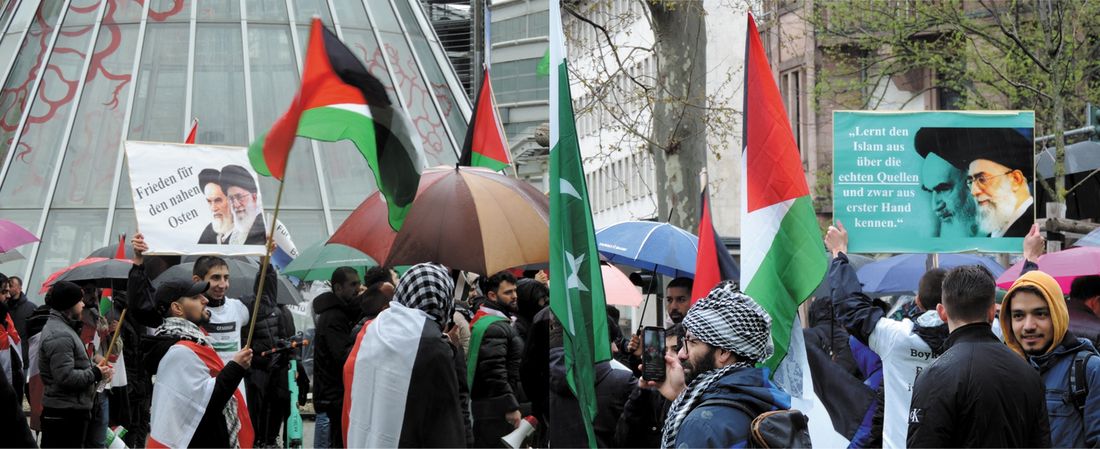
March.
Posters with the likenesses of revolutionary leader Ruholla Khomeini and his successor Ali Khamenei were also displayed, captioned with the phrases "Learn about Islam from the real sources, first-hand" or "Peace for the Middle East".
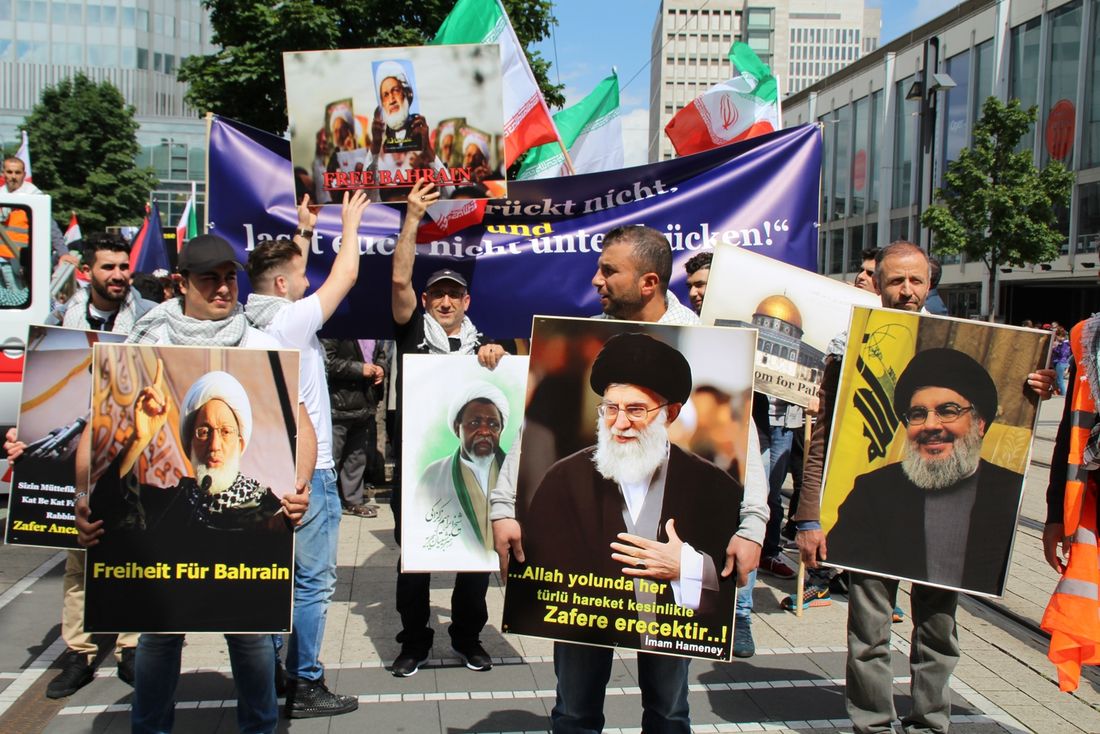
Khamenei, Hassan Nasrallah in 2017.
In 2016, the Frankfurt Quds Day was even organised under the motto "No to racism and no to Zionism "12 and a speech at this year's march referred to the feminist foreign policy of the Ampel government, which does not care about women's rights in Gaza. This certainly does not refer to the misogynistic restrictions imposed by the Hamas militia that administers the Gaza Strip. This seemingly left-wing vocabulary does not contradict the Shiite-Islamist orientation of the march, as Khomeini also speaks of Quds Day as the day of the poor and oppressed, who should unite to form the party of Allah, as shown above. The positive reference to the Iranian regime, the Islamic Revolution and its supporters is therefore openly displayed.
Alongside the recurring images of Khomeini and Khamenei are the likenesses of Shiite religious leaders who are loyal to the Islamic Republic of Iran. These include the Nigerian preacher Ibrahim Zakzaky13 and the Bahraini cleric Isa Qassim14 .
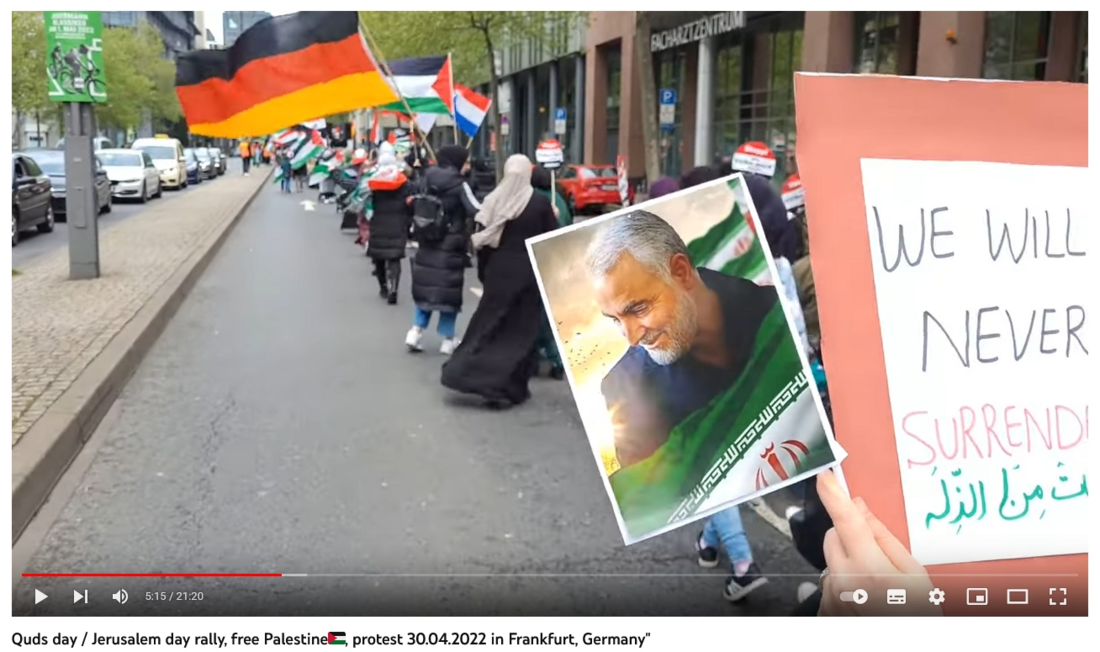
After the killing of the commander of the Iranian Quds Brigades15 , Qasem Soleimani16 , he was also honoured as a martyr on the way to the "liberation" of Jerusalem at the demonstrations in Frankfurt.
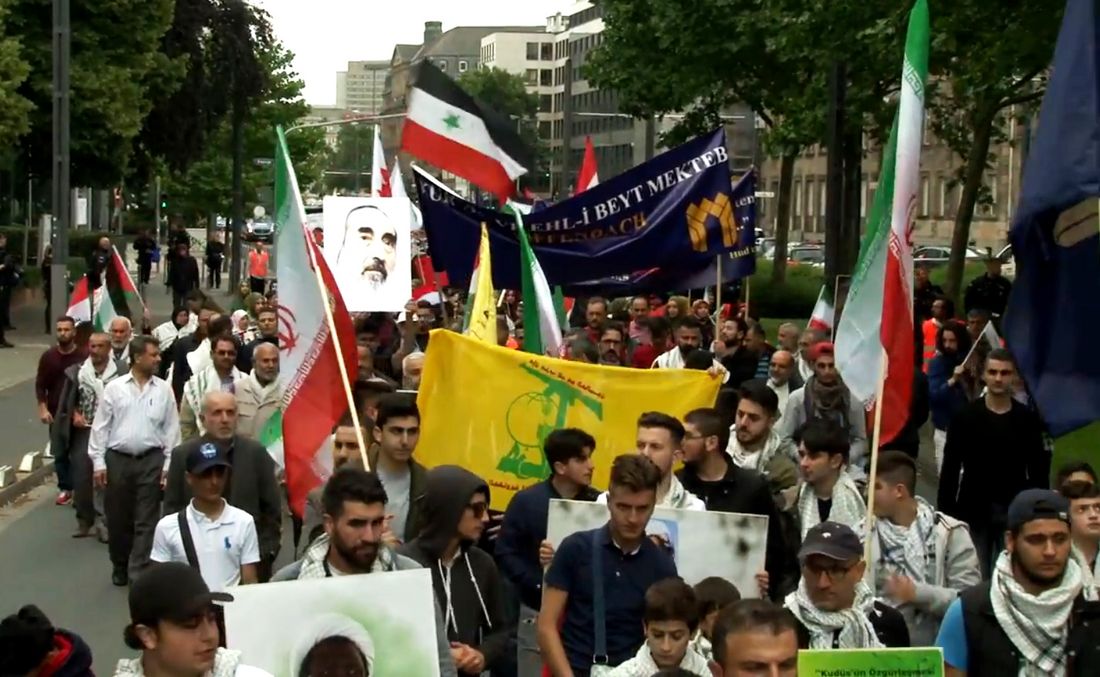
flags of Hezbollah and Iran as well as a banner of the Offenbach mosque community in
2016.
According to an evaluation by the Research and Information Centre on Antisemitism, a picture of the founder and spiritual leader of Hamas, Sheikh Ahmad Yassin, was also shown at the 2016 demonstration17.
Until the complete ban on Lebanese Hezbollah's activities in 202018 , the likeness of the leader of the Lebanese terrorist organisation, Hassan Nasrallah19 , and its symbols were also displayed in Frankfurt.20 In 2015, participants in the march were still chanting "Shoulder to shoulder with Hezbollah".21 This changed from 2020, but presumably less out of political demarcation than to strategically avoid repression. At the same time as the ban, Nasrallah's speeches appear to have disappeared from the video platforms that normally accompany Quds Day in Frankfurt in the media.22 On social networks, however, images with positive references to Hezbollah and Nasrallah can still be found on the network's profile.
The central importance of Quds Day in Frankfurt can be seen in the reporting of the Iranian state broadcaster parstoday, which has covered the demonstration in Frankfurt in the media at least once.23 Unlike the well-known Berlin march - where radical Islamists of various stripes take to the streets together with neo-Nazis and left-wing authoritarian anti-imperialists - the atmosphere in Frankfurt is characterised by family structures, demonstrating with children in gender-segregated blocks and appearing to come from the same political milieu. Every year, the same people appear as speakers, Koran reciters and organisers. More on this later. This milieu is predominantly Turkish-speaking and at least partly of Kurdish origin. Posters and speeches - and in the past also much more often slogans - are formulated exclusively in Turkish and German. Persian or Arabic can only be heard, if at all, in the Islamist background music from the loudspeaker van.
The organisational structure around the registering mosque community, the Offenbach Islamic Centre Ehlibeyt e.V., together with its Imam Muhammed Avci, who has since passed away, and other "Ehlibeyt" communities play an important role in the composition of this milieu. In the following, the political-religious background of the Ehlibeyt communities is first explained, and then the network surrounding the Offenbach community is analysed.

3.0 The Ehlibeyt network within the Islamic Shiite Community in Germany (IGS)
3.1 The theological background of Ehlibeyt Islam and Shi'ism
In 2019, the Zeitschrift für Religionswissenschaft (ZfR) published a text entitled Shiites, Alevis and Ehlibeyt Islam: Demarcation and articulation in the context of contemporary Shiite-Alevi cultures in Germany and Turkey, which, unfortunately in a very uncritical form, deals with the overlap between Shiite-interpreted Alevism and Shia Islam and analyses interviews conducted in Germany.24 The author Benjamin Weineck explains the term Ehlibeyt (Arabic: Ahlulbayt) used in Turkish as a common point of reference for an Islamically interpreted Alevism as well as for a Turkic-speaking Shia Islam with a point of reference to Azerbaijan or the Shia minority in Turkey25 , which mostly has Azerbaijani roots and is mainly located in the north-eastern border regions of Turkey, Iğdır and Kars.26 The term Ehlibeyt means "members of the house" and refers to the family of the Islamic religious founder Muhammad, which in the Shiite view includes his daughter Fatima and her husband Ali ibn Abi Talib, Imam of the later Shiites, as well as their two sons. With the death of Muhammad, a dispute arose over his succession and both Ali and one of Muhammad's fathers-in-law, Abu Bakr, laid claim to the title of caliph. This succession dispute is the basis of today's confessional division between Shiites (Ali as the rightful successor) and Sunnis (Abu Bakr as the rightful successor).27 The reference to the Ehlibeyt is thus synonymous with the support of Ali in the historical succession dispute of Islam and unites Shiites and a certain part of the Alevis (Alawi has the etymological meaning "follower of Ali"), who interpret Alevism as decidedly Islamic.28
The various currents of Ehlibeyt Islam share a unity in the Islamic succession as well as the recognition of the twelve Imams, of whom Ali is the first and Muhammad al-Mahdi the last, but who is supposed to live in secret until the Last Judgement. Reference is also made to the martyrdom of Ali's son Hussein in the Battle of Karbala against the Umayyad dynasty.29 The concept of Ehlibeyt serves to conceptually bundle the commonalities of faith orientations and overcome confessional division.30
According to Benjamin Weineck, of the 195 identified Shia organisations in Germany, around 43 are defined as Turkish-speaking, which accounts for between a quarter and a fifth of the total number of organisations. 31 In Germany, however, there is only one Shiite umbrella organisation, the Islamic Community of Shiites in Germany (IGS), which brings together the majority of organised Shiites with over 150 official member organisations from various national backgrounds.
The IGS was founded in 2009 under the leadership of the Iranian regime and aims to exert political and ideological influence on the individual Shiite organisations. The main organisation within the IGS is the Islamic Centre Hamburg (IZH)32 , which is described by the Office for the Protection of the Constitution as the "most important representative of Iran in Germany "33 and whose former head, Reza Ramezani, served, for example, as the German deputy of the current revolutionary leader Ali Khamenei in Iran.34 The IZH actors have clear personal and ideological links to the Islamic Republic of Iran and in turn exert influence on the Shiite umbrella organisation. For example, Mahmood Khalilzadeh, who worked in Frankfurt and who, according to a response from the German government, is "an Iranian scholar who is part of the political-religious establishment of the Islamic Republic of Iran", was the long-standing chairman of the IGS federal association.35 We will come back to Khalilzadeh later. The Islamic Centre Ehlibeyt e.V. from Offenbach is also organised in the Iranian-dominated umbrella organisation of the IGS. In total, there are 17 mosque communities in the IGS membership list that have the Turkish term Ehlibeyt in their names. Ramezani is also on the board of the University of Religions and Denominations in the Iranian city of Ghom, where he maintains close contact with the commanders-in-chief of the Revolutionary Guards. Ghom and the religious training centres there are central to Muhammed Avci's political-religious biography, as will be explained in the following chapter.

The three political leaders of the Islamic Center Ehlibeyt Offenbach in a row.
Nevertheless, even within the IGS there appear to be at least two pro-Iranian Ehlibeyt networks that organise their own events independently of each other. More on this later, using the Frankfurt Hazrat Fatima mosque as an example. The Turkish-speaking network of Ehlibeyt communities around the Offenbach mosque and its imam Muhammed Avci organises the annual Quds Day march in Frankfurt am Main. Avci is of particular importance in this context, which is why his person will be analysed in more detail below.
3.2 The person of Muhammed Avci and his significance for the Ehlibeyt network
After Avci's death in 2019, the likeness of the Offenbach imam is as present at the Frankfurt Quds demonstrations as that of the Iranian revolutionary leaders Khomeini and Khamenei. When the Ehlibeyt community in Offenbach celebrated the fortieth anniversary of the Islamic Republic of Iran in February 2019, Khomeini, Khamenei and Avci were figuratively placed in a row. These tributes and the letters of condolence published by key players in the Islamic Republic after Avci's death show how important the Offenbach imam was in the pro-Iranian network of Ehlibeyt communities within the IGS. But who was Muhammed Avci?
According to an Islamist encyclopaedia in German, Avci was born around 1948 in Palu, a village near the Turkish city of Elazığ in the predominantly Kurdish part of Turkey.36 However, what the German-language site does not mention is that Avci's family was not of Shia faith, but part of the Sunni Shafiite movement.37 In 2018, a biography of Avci's life was published in a small edition by the International Centre for Translation and Publication at Al-Mustafa University in Ghom38. The Persian-language book of around eighty pages was written by Khalil Mansouri39. It traces Avci's life in detail. From the age of twelve, he attended the Koran school at a local mosque, trained as an imam in the Sunni tradition and eight years later took on the role of prayer leader at the large mosque in Elazığ. With a brief interruption due to compulsory military service, Avci was a Sunni preacher until the power of the Islamic Revolution in 1979 led him to study Shia Islam and the teachings of Khomeini.40
Shortly after the Islamic Revolution in Iran, General Kenan Evren seized power in Turkey and assumed the office of president. Evren, who was part of the traditionally Kemalist-secular military, announced that there were no sources for the Muslim veil in the Koran, which, according to the biography, Avci firmly contradicted in his role as imam of the large mosque in Elazığ and wrote a letter to the Turkish ruler. Avci was subsequently imprisoned in Turkey and only released from prison in 1987 on condition that he not engage in any religious or political activity.41 Now an open supporter of the Islamic Revolution, Avci left Turkey a year later with his family and went into exile in the Netherlands. There he sought to join pro-Iranian religious circles, which is why he was briefly arrested by the Dutch authorities and his Turkish passport was temporarily revoked. Avci flew to Iran via Germany in 1990 to continue his religious education in one of the country's spiritual centres, Ghom.42 According to Iranian sources, he studied there with well-known clerics of the Islamic Republic such as the Ayatollahs Mousavi Ardebili and Abdollah Javadi Amoli, focusing on philosophy and Koran exegesis.43 The biography also mentions Ayatollah Mesbah Yazdi as a teacher and points out that although Avci was a clear ideological supporter of the Islamic Revolution and its claim to political power at this time, he did not organise the export of the revolution.44
Here in Ghom at the latest, Avci presumably professed the so-called principle of the "governor of the jurist" (Velayat-e Faqih), a political concept of Khomeini's rule45 , and presumably also acquired the Shiite clerical rank of Hodjatoleslam (Turkish: Hüccetülislam), which is below that of an ayatollah. With the task of translating his political convictions into practice, Avci returned to the Netherlands and founded the network's first pro-Iranian mosque community, the Ehlibeyt Centre Sakaleyn in The Hague. The aim was to politically mobilise and organisationally integrate the local Shiite community, to educate the children of Shiite migrants born in Europe in the teachings of the Ehlibeyt and the Islamic Revolution and to convince Sunni Muslims of the views of Khomeini and Shiite Islam. Avci is said to have succeeded in persuading more than 2,000 Muslims to convert within Islam.46 To this end, Koran and language courses in Persian and Arabic were offered, events relating to the Islamic Revolution were organised and regular trips to Iran were conducted, in which more than 500 students from the community are said to have taken part in recent years.47
Starting from the centre in the Netherlands, Avci and his followers built up a Europe-wide network and, according to his biography, founded further Ehlibeyt congregations in Germany, initially in the cities of Bochum and Frankfurt am Main.48 Further congregations in Germany were to follow.
3.3 The German Ehlibeyt network around Avci and the connection to the Netherlands
The fact that the centre of the network is located in the Dutch Ehlibeyt community and that Muhammed Avci himself was active there for a long time explains the special connection between Frankfurt Quds Day and the neighbouring country. Community members from The Hague regularly appear as speakers at the demonstrations, a cleric from the mosque, Seyyid Musevi49, was on site in Frankfurt for several years and occasionally Dutch flags can even be seen at the marches. When a motorcade was organised in 2021, several Dutch number plates were visible.
Muhammed Avci's son50 , İsmail Avci, regularly gives sermons that are edited on the network's media platforms, speaks at the Frankfurt Quds Day and also appears to still be a cleric of the Ehlibeyt Centre in The Hague, although his father moved to the Rhine-Main region in the early 2000s.51 In 2023, İsmail Avci gave a speech at the Frankfurt Quds March in which he ranted that the fate of humanity was threatened by a handful of mentally ill people, that the Zionists were playing people off against each other through the media and thus enforcing their right to continue enslaving humanity. Classic anti-Semitic conspiracies with a penchant for extermination.52

Republic in The Hague.
3.3.1 The Islamic Centre Osterholz
Imam Ibrahim Çakar is another central actor, both in text production and in online sermons on the network's media platforms, as well as in the annual Quds demonstrations. Çakar is one of the founders of the Islamic Centre Ehlibeyt Offenbach e.V.53 , but is now the chairman of the Islamic Centre Osterholz (IZ OHZ) near Bremen, where he is also the spiritual leader. Çakar, who previously lived in the Rhine-Main region, left the Offenbach association in September 2020. On the ideological media platforms, the 48-year-old is listed second most frequently behind Muhammed Avci, and he, Seyyid Musevi and İsmail Avci are present at most of the network's large gatherings.
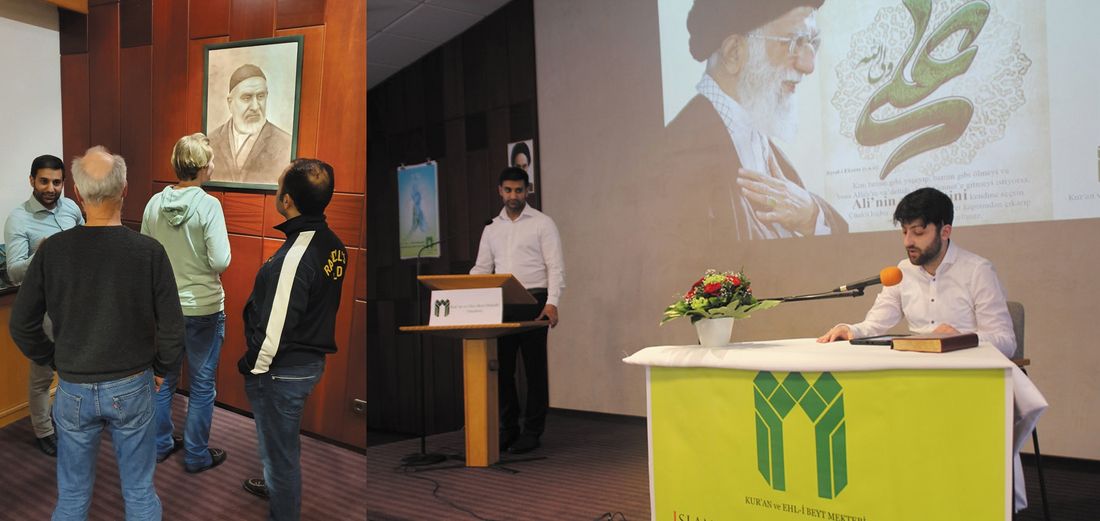
Muhammed Avci. The portraits of the Iranian leaders were safely removed for this purpose.
The IZ OHZ, on the other hand, is clearly affiliated with the Avci network, which is not only evident from the same choice of logo for the mosque communities in Offenbach, Osterholz and The Hague. Like Avci himself, Ibrahim Çakar is of Kurdish background. Together with his alleged relative Yunus Çakar, he not only runs the Kurdish sports club SV Azadi54, but also the association founded in 2004 around the IZ OHZ, which changed its name to Islamischer Verein Ahl-ul Bayt Osterholz Scharmbeck e.V. in 2016. At least two other suspected family members are part of the association structure. This observation corresponds well with the character of the Frankfurt Quds demonstrations, to which entire families seem to travel with their small children.
Yunus Çakar, born in 1992, appears in public as the first chairman of IZ OHZ and is also listed by name on the relevant news portals of the Ehlibeyt network. In his public image, he presents himself as democratic, interreligious and a peace activist; in 2023, he even completed an internship at the Institute for Intercultural and International Studies at the University of Bremen.55 He is a contact person for the local Protestant youth, with whom he would like to initiate an exchange56 and his speech at the Frankfurt Quds Day 202257, in which he describes himself as a political scientist, is peppered with anti-imperialist and peace policy vocabulary: Çakar criticises a lack of a culture of debate about Israel and believes the lesson from Germany's past is not to supply weapons to the Jewish state, which is not a democracy anyway, but much more a project of apartheid and colonisation. "Apartheid is the most racist form of fascism. And racism and fascism must be fought, "58 the political scientist states in his supposedly razor-sharp analysis. Yunus Çakar criticises Israel for an apparent lack of freedom of the press and religion and the inadequate enforcement of women's rights; all this while posing in front of the likenesses of Khomeini, Khamenei, Avci and Abdul-Malik al-Huthi, the Yemeni rebel leader of a civil war party modelled on the Lebanese Hezbollah, Ansar Allah, also known as the "Huthi rebels".59
After the killing of the Iranian commander of the Quds Brigades, Qasem Soleimani,
Yunus Çakar appeared as a speaker at a protest rally in the Netherlands. On the first
anniversary of the killing, he was interviewed by a television crew in front of the
Brandenburg Gate and protested in front of the US Embassy in Berlin in memory of
Soleimani and the brigadier general of the Revolutionary Guards and the head of
the Iranian nuclear weapons program, Mohsen Fakhrizadeh.60
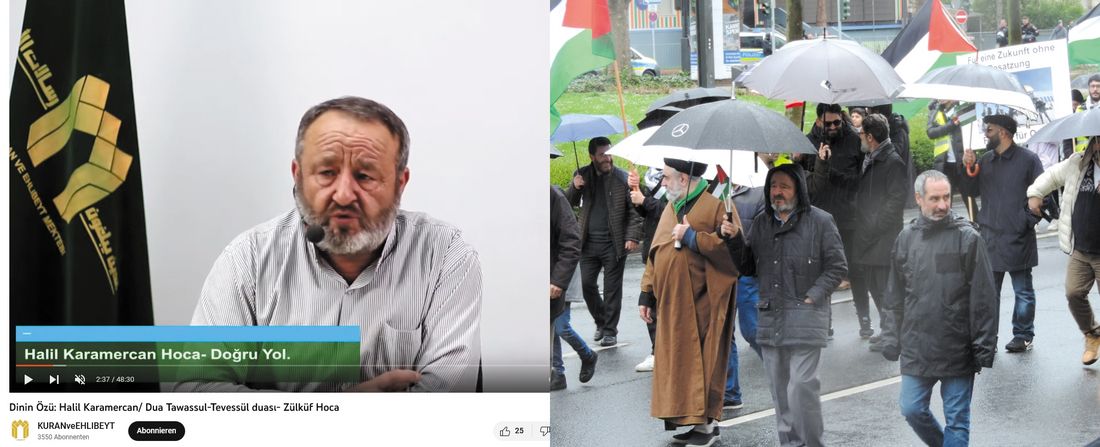
Seyyid Musevi.
3.2.2 The Augsburg association Ehl ul-beyt Kultur
Another central association in the Ehlibeyt network is the Augsburg mosque
association Ehl ulbeyt Kultur e.V. and its Imam Halil Karamercan. Karamercan is a
long-time companion of Avci and, like the other spiritual leaders, is present at many
of the networks events. The Augsburg branch has its own video channel with
sermons and events. 61
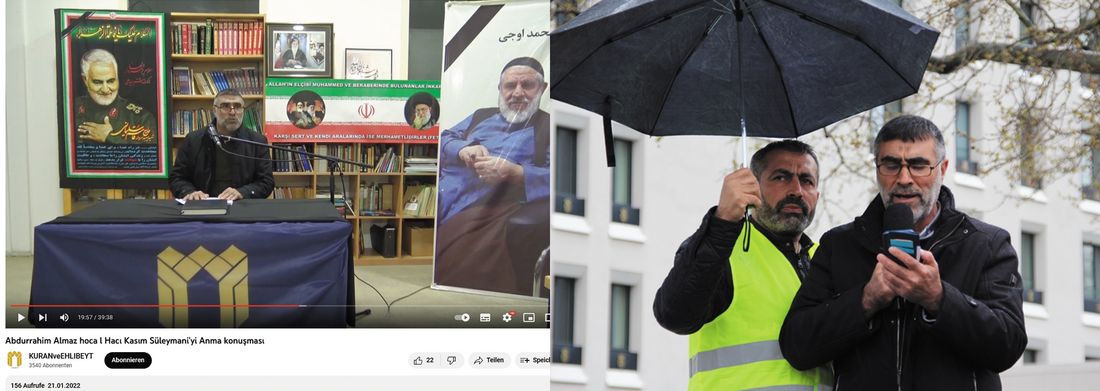
March.
Both in Augsburg and Osterholz-Scharmbeck, as well as in Frankfurt, separate
motorcades took place in 2021 to mark Quds Day. 62 Another actor in the network is
the cleric Abdürrahim Almaz, who appears - albeit less frequently than Avci, Çakar
or Karamercan - in the networks online sermons and who took on the task of
reciting the Koran at the Frankfurt Quds Day in 2023.
3.4 Interim conclusion
The structure behind the Frankfurt Quds Day can be found in this network of
Turkish-speaking Ehlibeyt communities within the Islamic Community of Shiites in
Germany (IGS). The common link between the listed actors lies in their connection
to the spiritual founder of the network, Muhammed Avci, in their organization
within the Iranian-influenced IGS, and in their support for the ideology of the
Iranian regime. The central organizational structure is based on the personal
potential of the Ehlibeyt communities in the quadrangle of The Hague - Offenbach -
Osterholz - Augsburg. Even though almost all of the networks events take place in
these cities, the radius of influence probably extends well beyond these cities and
municipalities. The aim of the associations is to publicize the positions of the
Iranian regime in Germany using vocabulary adapted to local conditions and to
bind Turkish-speaking young people from the second and third generations to the
Ehlibeyt network within the IGS and the ideology of the Islamic Republic. Before
giving an outlook on the network after the death of its founder, an insight will be
given into the ideological and personal connections to two other regional member
organizations within the IGS. The first is the Iranian Center of Islamic Culture and
the second is the Hazrat Fatima Mosque, which is attended by Shiites of Turkish and
Pakistani origin.
4. reference to regional IGS organization
Even though the Ehlibeyt network around Avci represents a functioning cosmos
within the IGS with its own news, sermons and almost two dozen gatherings per
year in its own community, there have been repeated links to other IGS member
organizations in the Rhine-Main area in the past. Although representatives of the
two mosque communities mentioned above did not appear at the Quds marches in
Frankfurt, Khalil Mansouri openly states in the biography of Muhammed Avci
published by Al Mustafa University that Iranians also took part in the marches. 63 It is
therefore reasonable to assume that at least members of the two communities who
do not hold public office within the organization took part in the demonstrations.
4.1 The Hazrat Fatima Mosque in Frankfurt
The Hazrat Fatima Moschee e.V. actually corresponds exactly to the religious
spectrum that has already been subsumed under the term Ehlibeyt Islam above,
while the community is also organized in the IGS network, which is influenced by
Iran. However, the association was founded in Frankfurt in 1991 and is therefore
older than the Ehlibeyt network around Muhammed Avci, at least in the Rhine-Main
region. Without exception, the founding members were born in the Turkish city of
Iğdır, which indicates that they belong to the Azerbaijani Shiite minority in Turkey,
which, as explained above, is particularly well represented in this region. The
observation that the Azerbaijani flag was present at the Ashura 64 conference of the
so-called Avrupa Ehlibeyt Gençliği (European Ehlibeyt Youth) in Leverkusen in 2019,
which was attended by half a dozen Ehlibeyt-related communities in addition to the
Hazrat Fatima Mosque, fits in with this. This indicates that the Hazrat Fatima
community is another Ehlibeyt network within the IGS that is more closely related
to Azerbaijan, despite its consistent ideological reference to Turkish-speaking Shia
Islam and Khameneis claim to power and the Islamic Revolution.
Not only are there no Azerbaijani flags to be seen at the Quds demonstrations in
Frankfurt, but there are a few Kurdish flags instead. In the past, the Hazrat Fatima
community did not openly mobilize together with the network around Muhammed
Avci, and the Hazrat Fatima mosque does not appear in the event reports of the
Avci groups. On the other hand, none of the four major communities of the Avci
network were present at the Ashura conference of the European Ehlibeyt Youth.
Whether the network around Avci, in contrast to the Hazrat Fatima community, is
predominantly Kurdish would have to be verified. However, the absence of central
figures from the Hazrat Fatima community from the Quds marches is probably also
simply strategic, as the mosque has already had problems with negative attention
in the past. The communitys former imam, Sabahattin Türkyilmaz, took part in an
anti-Semitic demonstration in Berlin in 2006 during the Israeli invasion of southern
Lebanon and was recognized by the media magazine defacto, which subsequently
reported on it. 65 Initially, the community council stood in front of Türkyilmaz, who
was born in Iğdır, Turkey, and had trained as a Shiite cleric for eight years in Ghom,
Iran. 66 When a sermon from 2009 in which Türkyilmaz referred to Khomeini and
prayed for Allah to liberate occupied Palestine from the hands of the Zionists finally
became public, the board of the Hazrat Fatima community felt compelled to
officially part ways with its imam the following year. The general secretary of the
mosque and former board member of the IGS Ünal Kaymakçi 67 claims not to have
known anything about the sermon. 68
While Türkyilmaz asserted in his resignation statement that the accusation that he
was acting anti-Semitically simply because he had taken part in Quds Day
demonstrations was 'Zionist trap'69 , the cleric continued to appear as a speaker
at events organized by the Hazrat Fatima community even after his official
resignation in 2010. The associations dissociation thus clearly points to a strategic
maneuver.
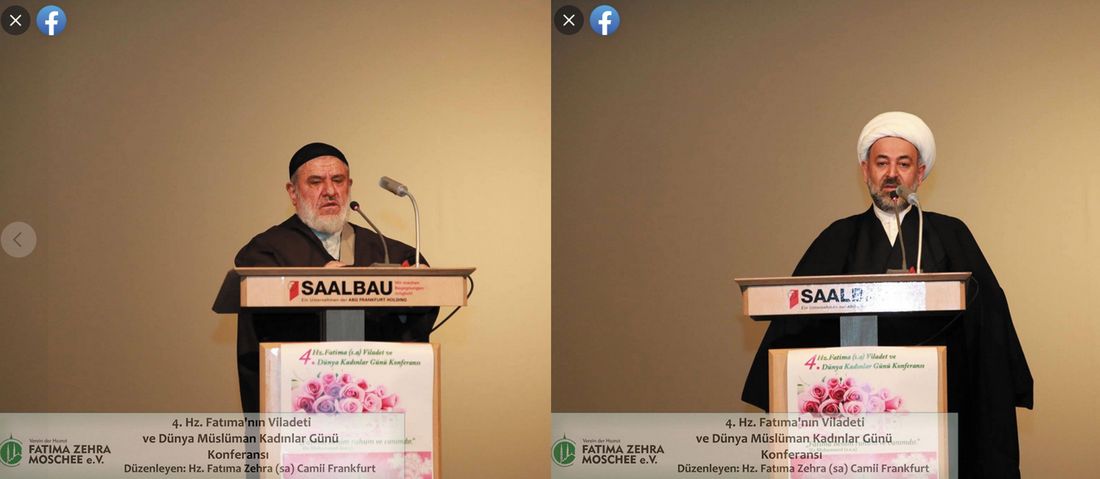
community in 2017.
Even though the representatives of the Hazrat Fatima mosque apparently did not
take part in the Avci networks Quds Days, Muhammed Avci did appear as a speaker
at at least one event organized by the mosque association before his death.
4.2 The Center of Islamic Culture Frankfurt
In addition to Avci, Mahmood Khalilzadeh, who is referred to above as a scholar of
the Iranian establishment 70 , was invited to speak at the same Hazrat Fatima Mosque
event in 2017, representing the Iranian-influenced Zentrum der Islamischen Kultur
e.V. (ZIK) from Frankfurt Rödelheim as a board member.
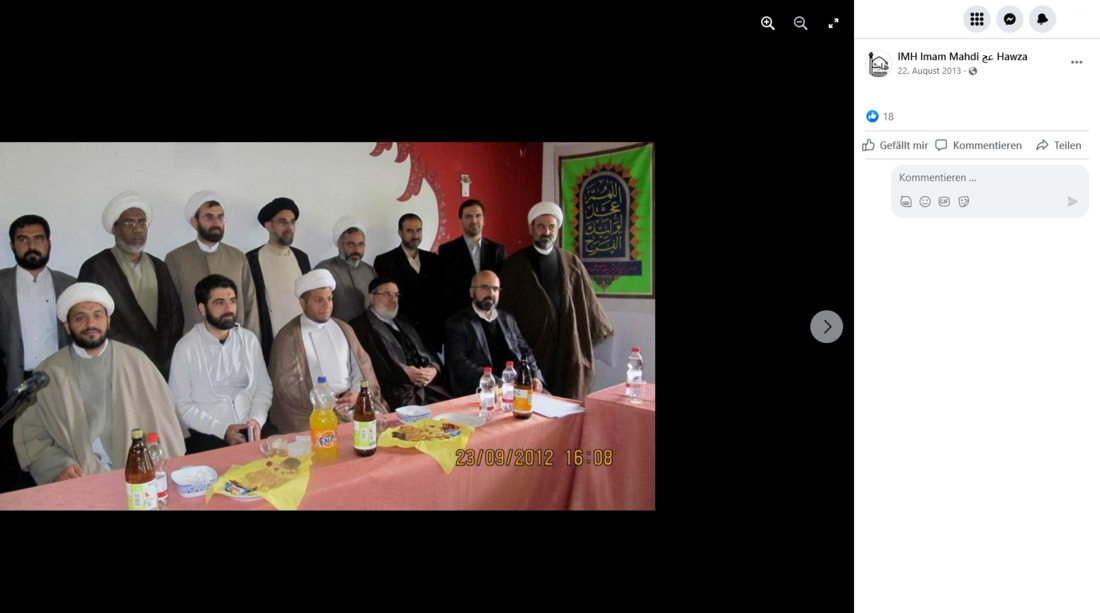
together in Langen.
The ZIK has clear links to Iran and Khalilzadeh, who like Avci bears the religious title
of Hodjatoleslam, is not only a key player in the Rhine-Main region, but was also the
national chairman of the Iranian-dominated umbrella organization IGS for a long
time. Consequently, the mosque regularly hosts mourning ceremonies on the
anniversary of Khomeinis death, celebrations to mark the anniversary of the
Islamic Revolution and a memorial event for the Iranian shadow general Qassem
Soleimani, at which Khalilzadeh appeared as a speaker. 71 As with the Hazrat Fatima
community, there are occasional points of contact between the association
brothers Mahmood Khalilzadeh and Muhammed Avci. For example, both appear in
pictures of an event that took place at the Shiite Imam Mahdi Cultural Center in
Langen near Frankfurt in 2012.
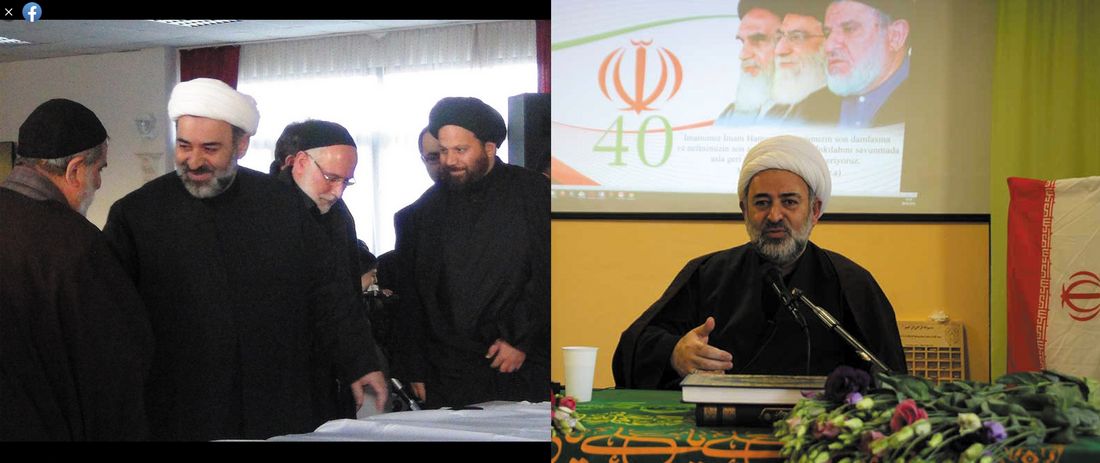
2019.
A year later, Khalilzadeh is also recognizable in photos in the networks of the
Ehlibeyt communities around Avci and when the fortieth anniversary of the Islamic
Republic was celebrated in the Offenbach Ehlibeyt Mosque in 2019, Khalilzadeh was
there with his deputy Mohammad Hassan Mokhber and once again appeared as a
speaker.
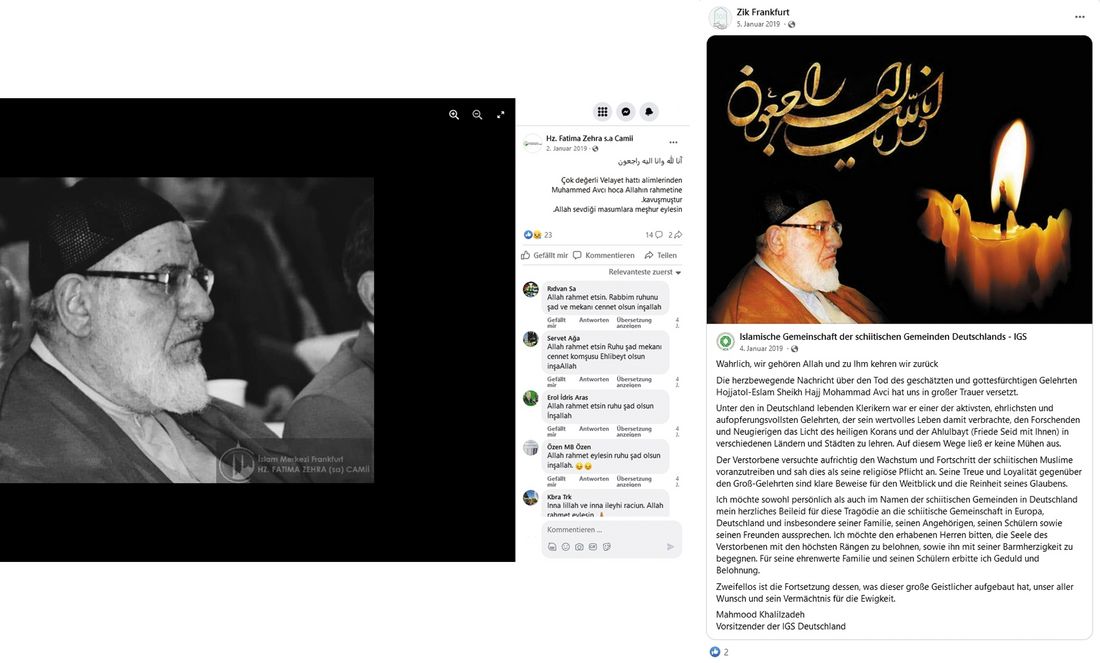
communities.
The ZIK, led by Khalilzadeh, also regularly publishes statements to mark Quds Day,
which at first glance seem innocuous. In 2020, for example, the spirituality and
cohesion of the Abrahamic religions and the fight against injustice were invoked:
'This day symbolizes the cohesion of people against darkness, inequality and is a
symbol of the mercy of people and the common striving for a better world' it says.
In the following year, similarly nebulous terms such as 'oppression and malice'
were used. 72 What exactly this darkness is and who embodies it for the ZIK can of
course only be guessed at against the backdrop of the annihilationist anitsemitism
of the Islamic Republic of Iran.
The narrative of Quds Day as a day of struggle against oppression can also be found
in the above quote from Khomeini. Since the participation of the leadership of the
Hamburg IZH in the Quds marches in Berlin has caused negative press in the past 73 ,
the actors of the ZIK and the Hazrat Fatima community probably decided against
participating in the demonstration in Frankfurt primarily for strategic and not
ideological reasons. Both the Hazrat Fatima community and Mahmood Khalilzadeh,
in his role as federal chairman of the IGS, wrote letters of condolence for the
Offenbach imam Muhammed Avci in 2019, and even Khameneis representative in
Germany and chairman of the Hamburg parent organization IZH, Mohammed Hadi
Mofatteh 74 , stated: 'The death of this great scholar is all the more bitter for me
because I had heard a lot from this great man who congratulated me on my taking
office as head of IZH in a joint telephone call and we had already arranged a date
for a meeting. Unfortunately, by divine providence, this will no longer happen.'75
Muhammed Avci has managed to establish a functioning network within the IGS,
which has built up structures in its own community and is ideologically and
personally well connected to central players in the Iranian regime and the Iranian-
influenced IGS. He is a central figure for the political mobilization of mainly Turkic-
speaking Shiites in Western Europe. Nevertheless, this network appears to have
been largely centered on the person of the Offenbach imam. With a look at the
death of the networks founder, the text will conclude in the following chapter.
5 The death of Muhammed Avci and the future of the
network
During a pilgrimage to various holy cities in Iraq and Iran in 2019, seventy-one-year-
old Muhammed Avci succumbed to a heart attack in the Iranian pilgrimage
metropolis of Mashhad. His body was transferred to the city of his spiritual training,
Ghom, where he was laid to rest in the shrine of the Shiite saint Fatima Masuma
with the blessing of revolutionary leader Khamenei. 76 Among those taking part in
the procession through the holy city were the imams of the Avci network, Halil
Karamercan (Augsburg), Seyyid Musevi (The Hague) and Ibrahim Çakar (Osterholz),
as well as other people who have been present at the Quds marches in Frankfurt in
the past. The prayer was held by the high-ranking scholar and teacher of Avci,
Abdollah Javadi Amoli. 77
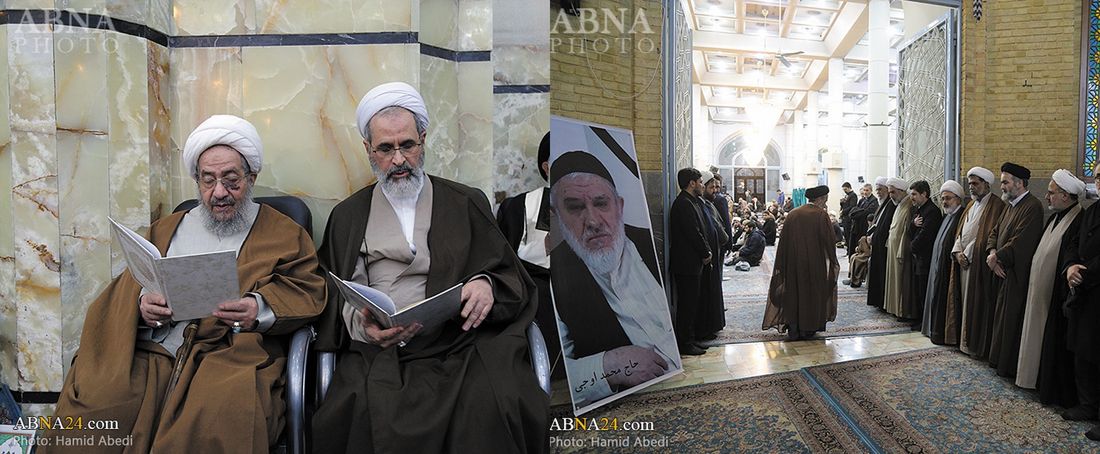
Supreme Council of the school in
Ghom. Brothers in spirit in rank and file, İsmail Avci clutches his chest as a sign of
gratitude.
In addition to Ayatollah Amoli, the former head of the IZH, Reza Ramezani, and
other high-ranking clerics of the Iranian regime were also present at the associated
funeral service. These included Ayatollahs Morteza Moghtadai, Alireza Arafi and
Alavi Boroujerdi. The mourning ceremony was organized by the Administrative
Center of Islamic Seminaries in Ghom, the International Al-Mustafa Community, the
World Assembly of Ahlul Bayt, the World Association for the Rapprochement of
Islamic Schools of Thought and the Noor Research Center for Islamic Studies. 78
The high-ranking representatives of the Islamic Republic during the funeral
procession and the burial ceremony illustrate Avcis status as an important player
on behalf of the Islamic Revolution and as a central coordinator of the activities of
mainly Turkish-speaking Shiites in Western Europe. In an obituary 79 by Ali Ekber
Velayati 80 , the foreign policy advisor to the Iranian revolutionary leader, he not only
praises Avcis efforts to found Islamic centers in Frankfurt, Augsburg and The
Hague, but also his memberships in the high council of the World Assembly of
Islamic Awakening and the Universal Congress of the lovers of Ahlul-Bayt. Both
organizations are almost certainly part of the Iranian network and the
constitutionally guaranteed export of revolution. Exporting the revolution and
expanding the Islamic Republics ideological zone of influence was the life project
of the Offenbach imam Muhammed Avci, which he was able to realize with a certain
degree of success. Not only has Avci founded several centers in Germany and the
Netherlands where youth groups are educated according to Khomeini's ideology.
He also established a lively exchange with Irans leadership and Iranian-influenced
organizations in Germany and created connections that have outlasted his death.
The Quds Day in Frankfurt am Main and the religious celebrations of the Avci
network clearly show that the central actors of the Ehlibeyt communities are not
dependent on Avcis organizational talent, but that the pro-Iranian network has
remained viable in recent years even after his death and can continue to mobilize
several hundred people for events such as the annual anti-Semitic march on Quds
Day.
September 2023
If you have any questions, please contact Emil Mink at
info@mideastfreedomforum.org!
1This is mentioned in the magazine Al-Fajr, the magazine of the Islamic Center Hamburg (IZH). In issue eight from 1984, it is reported that over 3,000 people took part in a Quds demonstration in Cologne. Two years later, a similar demonstration was reported in Hamburg.
2Marz, Ulrike 2017: Modern anti-modernism. Anti-Semitic hatred of the West in the ideology of the Islamic Republic. In: Grigat, Stephan (ed.): Iran - Israel - Germany. Anti-Semitism, foreign trade and the nuclear program. Berlin: Hentrich & Hentrich Verlag. S. 114-134.
3Quoted from Wahdat-Hagh, Wahied: Chisb-Alah - Alahs party calls for destruction: On the history of AlQuds Day: www.hagalil.com/archiv/2005/10/al-quds-tag.html
4The constitutionally guaranteed export of revolution is noted in an answer from the Federal Government. Printed matter 18/13362, p. 3. https://dserver.bundestag.de/btd/18/133/1813362.pdf
5More background at Tagesschau '40 years of Hezbollah - The spearhead of Iran'
www.tagesschau.de/ausland/asien/iran-hisbollah-libanon-101.html
6The worldwide extent of the marches can be read in more detail in Wolter, Udo 2004: Beispiel Al-Quds-
Tag - Islamistische Netzwerke und Ideologien unter Migrantinnen und Migranten in Deutschland und Möglichkeiten zivilgesellschaftlicher Intervention.
7keinalqudstag.noblogs.org; As early as 2003, a pluralistic civil society alliance was formed with
exiled Iranian, Kurdish and Jewish organizations against the annual marches in Berlin. This can be read in the text by Udo Wolter, pp. 38-41.
8 In 2018, Vice News reporters conducted illuminating interviews with various participants of the Berlin Quds Day: www.vice.com/de/article/xwm7aj/wir-haben-demonstranten-beim-al-quds-tag-gefragtwarum-sie-israel-hassen
9TAZ protest against enemies of Israel: taz.de/Al-Quds-Tag-in-Berlin/!5599721/
10 See Hessian Report on the Protection of the Constitution 2021, p. 234.
11www.jungle.world/artikel/2023/16/auf-frankfurts-strassen-gegen-israel
12www.youtube.com/watch from 1:20:11
13More on Zakzakys network in the article by the National Council of Resistance of Iran: www.ncr-iran.org/en/publications/special-reports/report-irans-terrorist-network-in-africa-and-itsimplications/
14More on Qassim and his relations with Iran at the Council on Foreign Relations web.archive.org/web/20130205071705/http://blogs.cfr.org/husain/2012/04/27/irans-man-in-bahrain/
15The Quds Briagades are a special unit of the Iranian Revolutionary Guards whose declared aim is to
export the Iranian revolution. An interactive map of the organizations kidnappings, political murders and bomb attacks is worth seeing in the web archive: web.archive.org/web/20230320130444/institute.global/policy/irgc-global-tracker
16The anti-fascist group 'Critique and Intervention' from Osnabrück has written a lengthy article on the Iranian shadow general, the American military strike and the European reactions:
initiativekritikundintervention.wordpress.com/2020/01/08/zur-antifaschistischen-us-intervention-gegenqasem-soleimani/
17Read the 'Qudstag March 2019' evaluation by RIAS Berlin: report-antisemitism.de/monitoring/
18The Federal Ministry of the Interiors press release on the ban on all of Hezbollah can be found here: www.bmi.bund.de/SharedDocs/pressemitteilungen/DE/2020/04/betaetigungsverbot-hizb-allah.html
19A brief profile of Nasrallah can be found at the CFR: www.cfr.org/backgrounder/profile-hassan-nasrallah
20An article by Frankfurt Islamism expert Sigrid Hermann-Marshall deals with the Hezbollah symbolism shown in Frankfurt: https://vunv1863.wordpress.com/2018/11/18/hizbollah-fans-am-bieberer-berg/
21verfassungsschutz.hessen.de/publikationen/aktuelles-und-analysen/al-quds-demonstration
22For example, Nasrallahs speech linked in Hermann-Marshalls article is no longer available: vunv1863.wordpress.com/2018/11/18/hizbollah-fans-am-bieberer-berg/
23verfassungsschutz.hessen.de/publikationen/aktuelles-und-analysen/al-quds-demonstration
24Cf. Zeitschrift für Religionswissenschaften 27 (1), pp. 125-145. 25 Cf. Weineck 2019, p. 127.
26de.wikibrief.org/wiki/Azerbaijanis_in_Turkey
27Explaining the denominational divide would clearly exceed the scope of this article, a short background article can be found on Wissen.de www.wissen.de/bildwb/sunniten-und-schiiten-die-zwei-hauptrichtungen-des-islam
28Nevertheless, Alevism is quite separate from Quranic Shiism and a certain part of the Alevi community does not see itself as belonging to the Islamic Ummah, but as an independent religion. A background on Alevism and the question of belonging to Islam can be found at the Federal Agency for Civic Education: www.bpb.de/themen/europa/tuerkei/184986/die-aleviten/
29Cf. Weineck 2019, p. 133f.
30However, it should be noted that not every organization or mosque with Ehlibeyt in its name automatically belongs to the pro-Iranian network. Although the term refers to a theological connection to Shia Islam, more in-depth research is required to classify an individual mosque association.
31Cf. Weineck 2019, p. 132. In contrast, the Persian-language Islamist website ahl-ul-bayt.ir (henceforth abbreviated as ALB) reports a significantly higher number of Shia communities in Germany, at 240. Islamist websites must be treated with caution, as it is not clear how much information is provided to the site administrators. These sources are therefore named in the article, but not linked. However, screenshots and translations are available.
32The Hamburg State Office for the Protection of the Constitution has dedicated a separate brochure to
the Iranian outpost IZH: www.hamburg.de/contentblob/15263774/e9cee39187a321fab70c4f5f24bfee85/data/izh-neueerkentnisse.pdf; The IZH recently took legal action against individual statements by the Office for the Protection of the Constitution and against the classification as Islamist and lost in court, at least in terms of the overall classification: www.zeit.de/news/2023-06/30/urteil-verfassungsschutz-darf-izh-islamistisch-nennen %3A%2F%2Fduckduckgo.com%2F
33Quoted from the following Welt article 'Why the enemies oppress us so much is obvious'
www.welt.de/politik/deutschland/article243024291/IZH-und-IGS-Einzige-Institution-der-Schiiten-befindetsich-in-der-Krise.html
34Further background information on Iranian influence on the IGS can be found at the Mideast Freedom Forum Berlin, in addition to the request to the German government already mentioned on page 2: www.mideastfreedomforum.org/fileadmin/editors_de/Texte/IGS-Policy-Paper_2019_03.pdf
35Reply of the Federal Government, printed matter 19/545, p. 5. dserver.bundestag.de/btd/19/005/1900545.pdf
36The short biography can be found on the website eslam.de, run by the brothers Gürhan and Yavuz Özoguz, who have a Turkish-Sunni background and have converted to Shia Islam. Yavuz Özoguz was present at the Frankfurt Quds Day in 2023. Even if propagandistic sources should be treated with caution, it can be assumed here that the main biographical sections of Avcis life correspond to the facts.
37ALB.
38Al-Mustafa University was placed on the sanctions list by the US authorities for training Shiite militias: www.rferl.org/a/iran-u-s-sanctions-religious-seminaries-network-al-mustafa/31014153.html
39Ayatollah Khalil Mansouri Ramsari is a scholar in Ghom and part of the Al-Mustafa International Community and may therefore also be in contact with the universitys Berlin branch. A biography of the Ayatollah can be found on the Persian website samamos.com.
40See Mansouri 2018, p. 16.
41See Mansouri 2018, p. 19.
42See Mansouri 2018, p. 20.
43ALB.
44See Mansouri 2018, p. 22.
45For an explanation of the term, please refer to the extremely readable text 'Der politische Islam der
Zwölferschia' by the Austrian Documentation Center for Political Islam. The principle of the 'governor of the jurist' is explained in detail here: www.dokumentationsstelle.at/wp-content/uploads/2022/11/DPI_GB_Zwoelferschia.pdf
46ALB.
47Cf. Mansouri 2018, p. 26, p. 39f, p. 47.
48See Mansouri 2018, p. 10.
49Sometimes also referred to as Seyyid Musavi, which is probably due to the translation from Persian.
50In a Turkish-language letter of condolence on the Welayetnews.com website dated 3 January 2019, İsmail Avci is referred to as the son of the deceased network founder.
51See Mansouri 2018, p. 22.
52The Turkish-language speech has not been published, but is available on video.
53To see the article by Sigrid Hermann Marshall: vunv1863.wordpress.com/2018/11/18/hizbollah-fans-am-bieberer-berg/
54www.weser-kurier.de/sport/ein-historischer-kaltstart-doc7e45ar5cerpy4ma5d03
55www-alt.iniis.uni-bremen.de/personen/yunus-cakar/
56Cf. local edition of the Protestant newspaper "An-Kreuzen" p. 13: www.kirche-pennigbuettel.de/damfiles/default/kg_emmaus_pennigbuettel/PDF/Ankreuzen/Nr.-03-2020/ankreuzen_3_2020_WEB.pdf-063fcef49a6c54bfd005788df7e4f57e.pdf
57www.youtube.com/watch
58www.youtube.com/watch Minute 13:15
59The Ansar Allah logo is adorned with the Arabic slogan: 'God is the greatest, death to America, death
to Israel, curse the Jews, victory for Islam' Further information on the Yemeni group can be found in
the Al-Monitor: web.archive.org/web/20150213230210/http://www.al-monitor.com/pulse/originals/ 2015/02/iran-yemen-houthis-axis-of-resistance.html#
60A portrait of the head of Irans nuclear weapons program can be found in the Guardian: www.theguardian.com/world/2020/nov/27/mohsen-fakhrizadeh-thought-to-be-key-figure-in-
irans-nuclearefforts
61www.youtube.com/@kuran-veehlibeyt-augsburg2000
62A report on the Augsburg convoy can be found in the Süddeutsche Zeitung: www.sueddeutsche.de/bayern/islamisten-augsburg-hasspropaganda-1.5486073
63See Mansouri 2018, p. 63.
64Ashura is a memorial ceremony that is significant for Shiites and commemorates the death of Alis son Husain in the Battle of Karbala.
65The two defacto contributions can be viewed in the following account, which presumably belongs to the political right-wing spectrum: www.youtube.com/watch
66An overview of Türkyilmazs career can be found in this FR article: www.fr.de/rhein-main/imamunter-verdacht-11677685.html.Türkyilmaz is a certain figure in the Shiite landscape in
Germany: not only was he a founding spiritual member of the Imam Riza Mosque in Berlin, which is close to the Iranian regime and Hezbollah (https://www.tagesspiegel.de/berlin/neukollner-moschee-trauert-um-getoteten-generalsoleimani-5048443.html), but he is also a translator for the Shiite-Islamist publishing house Eslamica.
67The fifty-year-old lawyer was remanded in custody in April 2023 together with an Iranian citizen, accused of being the head of a smuggling network. www.spiegel.de/panorama/aufenthaltserlaubnisse-fuer-deutschland-edelschleusung-nach-
pirmasens-ac44ccf09-120c-4fa4-859d-78d8039f2043
68www.israelnetz.com/frankfurter-imam-betete-fuer-befreiung-palaestinas-aus-zionistenhand/www.faz.net/aktuell/rhein-main/frankfurt/hazrat-fatima-moscheegemeinde-
frankfurter-moscheeverein-unterstarkem-druck-1940770.html
69 The 2010 statement, published on the Imam's Wordpress blog, quote on page 3: freitagskanzel.files.wordpress.com/2010/02/offentliche-erklarung.pdf
70Reply of the Federal Government, printed matter 19/545, p. 5. dserver.bundestag.de/btd/19/005/1900545.pdf
71Hessischer Verfassungsschutzbericht 2021, p. 235. Also described in an article in the weekly newspaper Jungle World "Die Mullahs in Rödelheim" https://jungle.world/artikel/2023/12/die-mullahs-roedelheim The ZIKs links to the IZH were recently confirmed in a small question to the Hessian state government. Printed matter 20/11305 starweb.hessen.de/cache/DRS/20/5/11305.pdf
72The entire statements can be found on the ZIK website in the archive, May 2020 - May 2021.
73iraniansforum.com/eu/fuhrungsmitglied-des-islamischen-zentrum-hamburg-beim-al-quds-marsch-in-berlin2016/
74The Federal Office for the Protection of the Constitution describes Mofatteh as a representative sent by
Khamenei to implement Iranian revolutionary exports in Germany: www.verfassungsschutz.de/DE/verfassungsschutz/der-bericht/vsb-islamismus-und-islamistischerterrorismus/2021-vsb-islamismus-und-islamistischer-terrorismus_artikel.html
75Mofattehs quote can be found in the short biography of Avci on the Islamist website eslam.de
76The Persian-language websites jzac.ir/iqna.ir and the aforementioned website ALB reported on this.
77The mention of Ayatollah Amoli as a prayer leader can be found on the Iranian website Samamos.com.
78According to a report on the ceremony on the Iranian website Iqna.ir
79The obituary can be found on the website of the Avci network Welayetnews.com from 10.01.2019.
80The Argentinian government has issued an arrest warrant for eight masterminds of the 1994 bomb attack on the Jewish cultural center Amia in Buenos Aires, which was carried out by Hezbollah and initiated by Iran. Among them is Ali Ekber Velayati. www.welt.de/print-welt/article90143/Haftbefehl-gegen-Rafsandschani-erlassen.html
